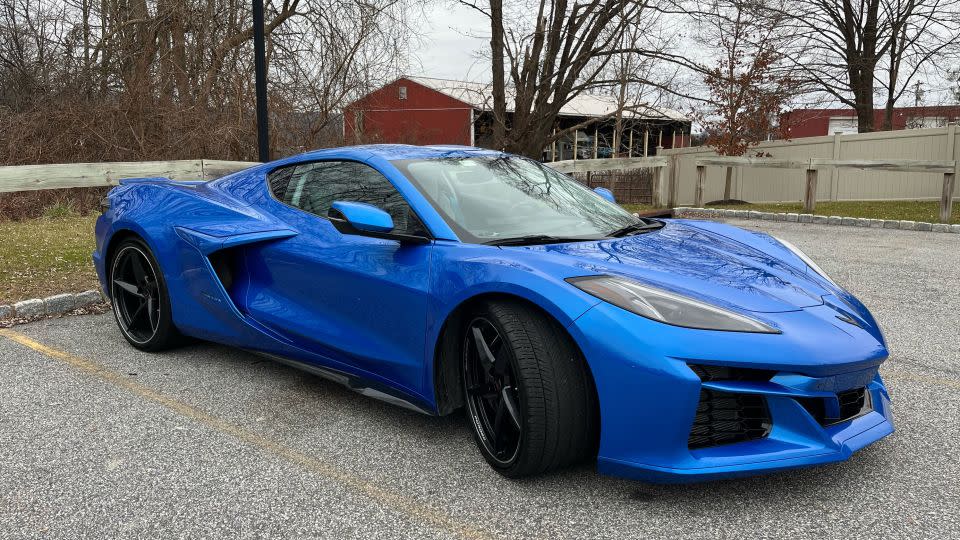GM’s 655-horsepower hybrid Corvette is a magnificent missed opportunity

General Motors is very clear that its engineers didn’t create the Chevrolet Corvette E-Ray, the first hybrid Corvette, to save gas.
That’s not what Corvettes are supposed to be about. Instead they wanted to make an all-wheel-drive Corvette, and the best way to do that was simply to attach a powerful electric motor to the front wheels. Meanwhile, a 6.2-liter gasoline engine mounted behind the car’s two seats drives the back wheels. With a total output of 655 horsepower, the E-Ray is the fastest-accelerating production Corvette ever.
For GM, efficiency was an afterthought, but for me, it was impossible not to think about fossil fuel combustion as I blasted up snowless mountain roads along the New York, New Jersey state line. Only a few years ago, test-driving a sports car this fast and powerful would have been reserved for late spring and summer months. Roads like this, at this time of the year, would have been often slick and icy. Instead, the tarmac looked black as the day it was laid as I drove past mountain resorts and summer homes.
There is no doubt. Things have changed.
Whenever traffic ahead cleared, I could press the gas pedal hard, hear that big V8 engine roar up to speed behind me and rip toward the next tight curve, giving me confidence I had the traction to whip right through. A digital screen showed me how much power the electric motor was adding to the mix while the gas engine worked the Corvette’s extra-wide back tires.
Like a regular gasoline-only Corvette, it still has an eight-speed transmission with paddle shifters, should you wish to shift gears yourself. (A manual transmission option went away in the latest generation.)
Unlike in a Toyota Prius, or almost any other hybrid, the E-Ray’s electric motor almost never drives the car on its own. There are a couple of selectable modes in which the electric motor can drive a few miles at very low speeds but, left to itself, the car will never turn off its gas engine.
Instead, when not too much power is needed, the engine will shut down four of its eight cylinders, running in “V4” mode. The regular non-hybrid Corvette Stingray, the base model, will do that, too. But the E-Ray, thanks to its electric motor, can run on just four cylinders a surprisingly long time, even while climbing shallow hills as long as the gas pedal isn’t pressed hard.
The result of all this technology is that E-Ray, with its supercar-levels of speed and power, gets fuel mileage nearly identical to the base Stingray. But the E-Ray has an additional 160 horsepower and all-wheel-drive, something never before available on any Corvette.
Clearly, fuel economy was at least somewhat of a consideration or the E-Ray could have had worse fuel efficiency than the base model. Instead, it’s almost exactly the same at 19 miles per gallon, overall, according to EPA estimates. (It’s one MPG worse in highway driving.) Compared to other high-performance sports cars, like the far more expensive Lamborghini Huracán, which is a little less powerful than the E-Ray, it’s very good.
Still, GM could have swung the fuel efficiency needle a little further. It certainly wouldn’t have been out of keeping with the Corvette’s traditional character. The Corvette has long been known for having relatively good fuel economy given its capabilities and, thanks to ample luggage space and comfortable seating, for being an excellent road trip sports car. (I’ve tried it in the past and it’s true.)
Just a few more miles per gallon would mean more miles between fill-ups and more time on the road. It also could show the world that GM knows how to reduce greenhouse gas emissions without reducing fun. Thanks to those different driving modes that are, really, just changes in software, engineers might not even have to reduce the E-Ray’s maximum horsepower. Although, let’s face it, 655 horsepower is a whole bunch. Knock off 50 or so and it’s still a very fast car, no apologies needed.
Let’s face it, though, 655 horsepower is a figure to be bragged about, but rarely, – if ever – to be used. The E-Ray is not really intended for track driving. For that, GM offers the lighter and more powerful Corvette Z06, with its high-revving 670-horsepower V8 and no electric motor. The E-Ray is intended as more of relaxed but fast cruiser.
And while it’s certainly possible to enjoy the car’s quick acceleration and responsiveness, there will be few opportunities on public roads to pull 655 horsepower out of it without facing immediate arrest or worse.
GM is not big on hybrids. It currently does not offer any hybrid models besides this one. Instead, GM has focused on fully electric technology and, before too long, there will be a fully electric Corvette. But, when it comes to reducing greenhouse gas emissions, hybrids matter a lot. GM could have made a statement to that effect with a (still) great hybrid Corvette that leaned a little more into helping the planet as well as performance.
For more CNN news and newsletters create an account at CNN.com

 Yahoo Finance
Yahoo Finance 